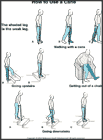
How to Choose and Use a Cane
What is a cane?
A cane is an aid to help you walk when you have a problem with your leg or foot. Canes come in different styles and are usually made out of wood or metal. You need to choose a cane that best suits your type of condition and the amount of support you need.
- Crook cane: This is the most common type of cane. It is the least expensive and is often used for temporary conditions like fractures or sprains. Many people prefer this cane because you can hang it over your arm when you're not using it and free both hands.
- Center balance cane: This cane is best if you need firm support and assistance getting up and down from a chair. It is the most popular cane for people with arthritis, hip problems, back problems, multiple sclerosis, Parkinson's disease, or strokes. It has a bigger, flatter handle that provides a comfortable and secure grip. Straps allow you to carry it or hang it when not in use.
- Brass handle or parrot head cane: If you need a cane only for balance or mild weight bearing, you might choose this cane. This cane is usually chosen primarily for the decorative handle.
- Quad Cane: The quad cane has 4 feet at the end of the cane. People who need maximum weight bearing and support often choose this cane. It is often used long term. If you need this level of support, you might be much safer with a walker
With a written prescription from your health care provider, most health insurance providers will cover the cost of a cane. Ask your health care provider about getting a disabled permit to park in handicapped zones.
How should a cane fit?
When you are standing upright with your elbow bent a little (about 30°), the top of the cane should meet your wrist joint.
How do I use a cane?
- Walking: Hold the cane in the hand opposite the injury or weakness (for example, you would hold the cane in your right hand if your left leg is the injured leg). Keep your elbow close to your body and your hand near your hip. Your hand should not move forward or out to the side; you should just pivot the wrist joint. Move the cane forward as you step forward with the bad leg. When weight is placed on the bad leg the cane will give support from the opposite side. Step past the cane with the good foot.
- Going up and down stairs: When you are going upstairs, lead with the good leg ("up with the good"). Then bring the bad leg and cane up the step. When you go down stairs, the cane and bad leg go first ("down with the bad").
- Getting up from a chair: When getting out of a chair slide the foot of your bad leg forward a little, push out of the chair using the hand on the weak or injured side and stand with your weight on the good leg. Use the cane to support your weight over the bad leg.
Safety Tips
- Wear sturdy, low-heeled shoes with nonskid soles to help prevent falls.
- Avoid wet floors and sidewalks that are slippery.
- Remove throw rugs from your path and watch for electrical and telephone cords that may cause falls.
- Keep your free hand on the railing when you go up or down stairs.
- Avoid revolving doors and escalators.
- Slow down and take extra time to stay safe.
Written by Pierre Rouzier, MD, and developed by McKesson Health Solutions LLC.
Published by McKesson Health Solutions LLC.
This content is reviewed periodically and is subject to
change as new health information becomes available. The
information is intended to inform and educate and is not a
replacement for medical evaluation, advice, diagnosis or
treatment by a healthcare professional.
Copyright © 2003 McKesson Health Solutions LLC. All rights reserved.

